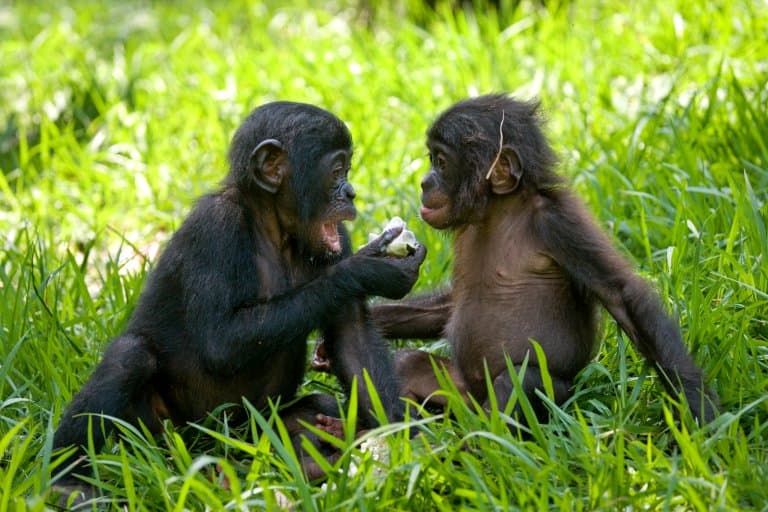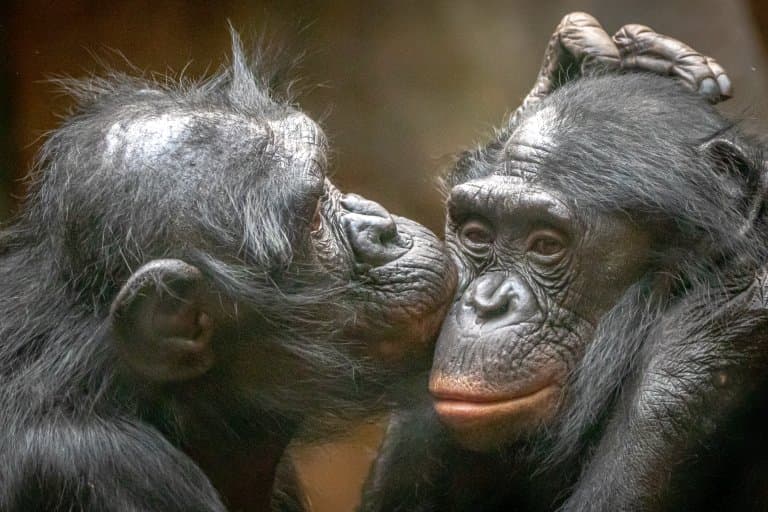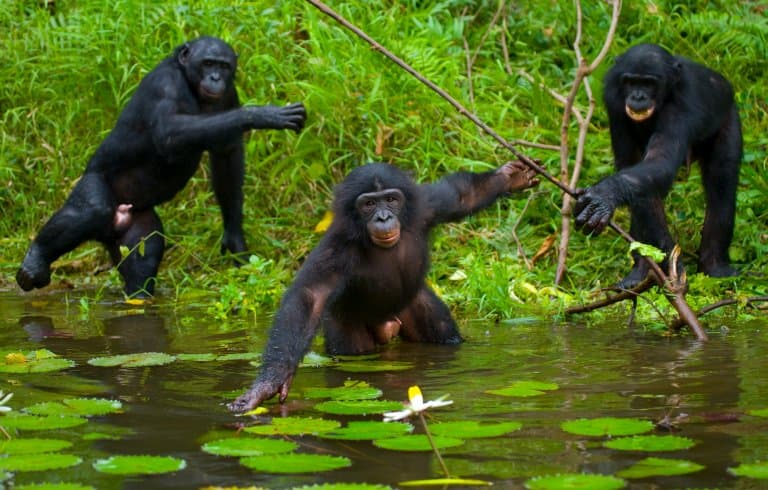Bonobo Profile
Back in our evolutionary history, around five to seven million years ago, our ancestors made a choice. This was a choice between love and war.
The lineage that would become humans took one path, and the lineage that would become chimpanzees took another. But around two million years ago, there was another discussion on the topic and the chimp branch had some creative differences among them.
Once again, the choice was simple: love, or war. The chimps decided war looked good after all, just like the human ancestors did. The animals that would later become the bonobos were too busy having sex with everything to notice.
The bonobo are a great ape in the same genus as chimps, previously thought of as a subspecies, but now considered their own distinct species. They have historically been referred to as the pygmy chimpanzee, or dwarf chimpanzee – despite their body size being similar to chimps.

Bonobo Facts Overview
| Habitat: | Forest |
| Location: | Democratic Republic of Congo |
| Lifespan: | 40 years in captivity |
| Size: | Around 5ft tall |
| Weight: | Up to 60kg (132lb) |
| Colour: | Black |
| Diet: | Mostly fruit, but they do sometimes hunt vertebrates |
| Predators: | Humans |
| Top Speed: | Unknown |
| No. of Species: | 1 |
| Conservation Status: | Endangered |
It’s not quite as straightforward as we may have suggested; bonobos, while they do enjoy shagging regularly and often, are more than capable of violence, too.
Still, as great apes go, they’re probably the most peaceful, at least of the social members.
Bonobos and chimps represent almost opposite ends of the social spectrum in several ways. While chimps are characterised by aggressive male dominance, bonobos are matriarchal, altruistic, and generally pretty chilled.
They are distinguished in appearance from chimps by their often more slender body shape, longer limbs, darker face and pinker lips. They are also predominantly frugivorous, whereas chimps have more of an omnivorous diet, where they will eat animals like smaller monkeys too.
Still, we know very little about them on account of them living in some very hard-to-reach places.
Interesting Bonobo Facts
1. They are our closest living relative
Bonobos and chimpanzees are the two species which make up the genus ‘Pan’, and are the closest living relatives to humans.
They share over 99% of their DNA with chimps, and 98.7% of their DNA with humans.

2. Amazingly, we don’t even know how many there are
There are up to 300,000 chimps in the world. They span 21 countries and numerous forests. They’re one of the most tracked and studied animals in the world, and yet their slightly smaller cousins are restricted to the Congo Basin and only 30% of their habitat has been surveyed.
It’s estimated that there are at least 20,000 individuals but with such a small amount of habitat covered, this is a very rough guess. 1
3. 13 seconds in heaven
Sex for a bonobo is somewhat like shaking hands. It’s used as a greeting, a bonding experience and as a way to assert dominance. Copulation rates are higher in bonobos than in any other ape, yet reproductive sex seems to be on par with chimpanzees.
A quickie typically lasts around 13 seconds and can occur between any pair of bonobos, regardless of sex, age, or relation.
Same-sex sessions are particularly common among female bonobos and seem to represent a display of close friendship and love. This may even be one of the ways that females gain a higher ranking than males. 2
4. They’re matriarchal, mostly
Bonobo society is relatively egalitarian, particularly compared with other apes, and sex is part of this. It’s hypothesised that sex plays a similar social role as aggression does in their close relatives, to both assert hierarchical positions and create alliances.
Domance between a male and female bonobo is usually in the favour of the larger male, which explains why female-to-female bonding is so important.
But it’s not clear-cut at all. A dominant female will still request food from a male, rather than stealing it. Yet in captivity, all bets are off. Females appear far more aggressive and can resort to violent food protection.
Bonobo male and female hierarchies overlap, with an apparent skew slightly towards female dominance. The females seem to have stronger bonds between them, and are also more nomadic, moving between communities. Something which might contribute to diffusing mate-related aggression. 3 4

5. They’re hard to study
There’s still so much we don’t know about bonobos, and this is almost entirely because of where they live.
Despite most of the planet having been ravaged by humans and their industry, there remains a vast amount of relatively undisturbed forest in the Congo basin.
This forest is already hard to reach physically, but due to civil unrest in the country, it’s not an easy place to spend time either. Because of this, the bonobo was one of the most recent large mammals to be discovered.
Deforestation by local communities is rampant, and poaching of bonobos is a known problem, but the extent to which these problems continue is still mostly unknown.
6. Males even tolerate children
In the brutal world of chimp society, only the children of the dominant male are safe. Infanticide is common in chimps, but in bonobos, it’s not so much a thing. In fact, bonobos are not known to kill one another at all.
Both males and females have been seen taking in orphaned children under their care, and in one case, a male fostered the child of his dead brother. One reason for the lack of aggression towards young bonobos is the sheer amount of sex everybody is having.
It turns out, nobody’s entirely sure which kids belong to whom. 5
7. Violence does happen
They’re not total pacifists, though. As mentioned, they’re far more eager to scrap in captivity, which likely says something about their complex hierarchy of needs as intelligent, social animals.
While in many cases, sex will be the introductory behaviour in the wild between two roaming groups, it’s not always the case. Sometimes fighting does erupt between rivals, either from n unknown group or as part of a display of dominance between an alpha female and a low-ranking member of the group. 6 7
8. But they’re generally kind to strangers
Not only are bonobos known to have communal feasts in which they share food with friends, but they’ve also been tested for altruism towards strangers too, and scored very highly.
Chimps are known to only help out another when it’s requested of them, but bonobos show signs of unsolicited generosity and kindness, further cementing them as the gentle cousin. 8
9. They can jump!
In one very specific study, the ability of a bonobo to jump up in the air was compared to that of a human.
A bonobo half the mass of the human was able to generate the same amount of power, demonstrating twice the force the researchers were expecting for the amount of muscle. 9
10. They are extremely smart
Like chimps, bonobos are one of the smartest animals in the world. They have self awareness and like all great apes, are able to recognize themselves in a mirror.
They are also able to use simple tools, and have been taught how to even make tools in captivity.
Two bonobos at the Great Ape Trust, Kanzi and Panbanisha have been taught to communicate using a keyboard labeled with lexigrams, which has a vocabulary consists of more than 500 English words.

11. They are endangered
While population estimates suggest there must be between 20,000 – 50,000 individuals, this population is believed to have declined sharply over the past 30 years.
There are major threats to the bonobo including the ongoing conflict in the Democratic Republic of Congo, habitat loss and hunting for bushmeat.
There are various conservation efforts from both local and global bodies investing in better protection and education of natives to help protect the bonobo.
Bonobo Fact-File Summary
Scientific Classification
| Kingdom: | Animalia |
| Phylum: | Chordata |
| Class: | Mammalia |
| Order: | Primates |
| Suborder: | Haplorhini |
| Infraorder: | Simiiformes |
| Family: | Hominidae |
| Subfamily: | Homininae |
| Tribe: | Hominini |
| Genus: | Pan |
| Species: | Pan Paniscus |
Fact Sources & References
- Fruth, B., Hickey, J.R., André, C., Furuichi, T., Hart, J., Hart, T., Kuehl, H., Maisels, F., Nackoney, J., Reinartz, G., Sop, T., Thompson, J. & Williamson, E.A (2016), “Pan paniscus“, The IUCN Red List of Threatened Species 2016.
- Maria Cohut (2019), “Why do female bonobos have more sex with each other than with males?”, Medical News Today.
- Gottfried Hohmann (2003), “Intra- and Inter-Sexual Aggression by Bonobos in the Context of Mating”, Brill.
- Nicola Jones (2018), “Bonobos Spied Sharing a Feast”, Sapiens.org.
- Martin Surbeck (2017), “Affiliations, aggressions and an adoption: Male–male relationships in wild bonobos”, Oxford Academic.
- “Bonobo Facts”, World Wildlife.
- Takumasa Yokoyama (2020), “Aggressive Behaviors among Wild Bonobos!”, Youtube.
- Elaina Zachos (2017), “Another Heart-Warming Way Apes Beat Us at Being Human”, National Geographic.
- Melanie N Scholz (2006), “Vertical jumping performance of bonobo (Pan paniscus) suggests superior muscle properties”, The Royal Society.
